Horses are mammals, and like other mammals, they carry a fetus in their belly and then give birth to a baby horse (called a foal). Horse pregnancy is a complicated process that is divided into several stages. If this is the first time your horse is pregnant, you may be wondering how to treat them properly. Thus, here’s an ultimate guideline about horse pregnancy signs and their timeline.
How Long Does a Horse Stay Pregnant?
In fact, the horse gestation period runs from conceiving to baby arriving. The entire horse pregnancy cycle takes 340 days on average (11 months). The range may differ slightly from 330 to 370 days. But 340 days is deemed as the most common due date before giving birth. Use our mare gestation calculator to find out the approximate date your horse to foal.
If the horse gestation period exceeds 370 days, it’s unconventional but not problematic. The longest horse pregnancy period recorded was 445 days! On the contrary, foals being born on the 300th day or earlier are unlikely to survive because of the organs not being developed enough.
Speaking of ponies, a miniature horse also needs about 330 days to carry and give birth to a foal. The due date may range from 320 to 380 days before the baby arrives.

What is the Best Time to Breed a Horse?
Naturally, horses are seasonal breeders, which means their reproductivity is different during the year with season switching. Mares’ estrous cycles are correlated to the length of the daylight. Thus, the highest activity is visible during long days in late spring and summer. This affects her behavior while showing the mare is in heat by being receptive to the stallion.
As mares’ breeding period is in summer, the foaling starts in spring or early summer the following year. This is a perfect time, as when the baby arrives, the weather is mild and there’s no lack of food.
However, breeders can make some manipulations to knock off the due day in order to have an early foal. Such practice is common in horse breeding for shows or sale. The main idea of accelerating the baby arriving is to artificially prolong the daylight to 14-16 hours a day. You should start the regimen in December in order to get a foal in early winter the following year.
It’s crucial to do tests on an ongoing basis to check the mare’s health condition and regular cycling. Besides, keep in mind that such a method doesn’t guarantee your horse’s early foaling. Lots of aspects should be taken into account like the mare’s well-being and age.

How to Tell If a Horse is Pregnant?
There are several horse pregnancy signs you may face when your horse is expectant. Here are the most common ones:
- No estrus – if a mare is in foal, she is in no heat. Horses are polyestrous animals, which means they have several periods of estrus a year. A heat cycle repeats every three weeks (21 days). Thus, if it’s been long since the last estrus, it’s time to go to the vet.
- No mate – if the stallion is ready to cover and the mare refuses, there’s a chance of her being already gestated. Get her back to the stallion and check her behavior. If she’s “in the mood” lifting her tail, like she typically acts in heat, there’s a low probability of the mare being conceived.
- Different behavior – it’s claimed that mares may act a bit differently, watching themselves, while pregnant. Horses start protecting their fetus from their first days with less motion. They shake their neck and head but not the body. Having said that, this method is not reliable for pregnancy determination.
- A bumpy belly – it’s one of the most obvious horse pregnancy signs. However, don’t neglect going to the veterinarian to examine the swollen tummy. Besides, as the due day takes almost a year, the shape of the mare’s body may stay almost the same.
In addition, there’s a chance your horse may not show any visible sign of being in heat. So you can think the horse gestation period begins. However, this is not the point, your mare is merely “silent heat” (covert mares). That means that the mare with a normal cyclic activity doesn’t exhibit usual signs of being in estrus. Thus, a veterinarian examination or an ultrasound is needed in order to determine the mare’s heat.

Ways to Horse Pregnancy Test
Apart from horse pregnancy signs, there are several ways of gestation testing to make sure your horse is conceived or not. These are rectal examination, ultrasound, and blood and urine tests. Such options are more accurate, as mares may not show any visible signs of being in foal.
- An ultrasound can be done after two weeks of the horse mate. This is the best way to find out whether or not your horse is expecting. Additionally, pregnancy determination consists of several periods. For instance, you can determine the fetus’ heartbeat at the first ultrasound session as well as twin-check. However, the sex of the foal can be detected on days 55-70.
- Blood and urine tests are usually done after two or three months after breeding. This option is more budget-friendly than an ultrasound. Estrogen molecules are being tested for high concentration by getting a sample of the mare’s blood and urine.
- A horse gestation can be checked by veterinarian examination. This can be done after six weeks after conception by uterus palpation. Such testing is cost-effective, however, it’s not reliable for early pregnancy determining. The vet can examine the fetus and confirm the estrus absence.

Horse Pregnancy Stages
When your mare’s conceiving is confirmed, it’s time to check the horse’s carrying at all phases. Generally, pregnant mares stages include three periods:
- days 0 (conception) to 90 – first three months. The beginning of pregnancy, the fetus is growing. The heartbeat can be determined in the first stage. By the end of the third month, the fetus has a horse-looking shape. Blood and urine tests as well as ultrasound should be done at this stage. The twins-check can be provided and if it’s positive, one embryo is usually pinched off in order to save the other foal. Otherwise, there’s a high probability of losing both fetuses.
- days 91 to 180 – next three months. The fetus keeps on growing and it looks like a little horse. The second trimester starts. The belly is becoming bigger and getting a bump shape. It’s not recommended to ride the mare starting from this horse pregnancy stage.
- days 181 to 340 – last five months. The common foaling day is on the 340th day. During the third trimester, the tummy is swollen immensely, especially if it’s not the first pregnancy. Do not ride the mare when she is in late foal. Use ultrasound to determine the day of the foal arrival. Besides, the teats are getting bigger. The colostrum may appear one or two weeks before foaling. The pelvic area starts relaxing three weeks before giving birth in order to ease the process of the foal going through. The vulva is stretching, so the baby could come out.
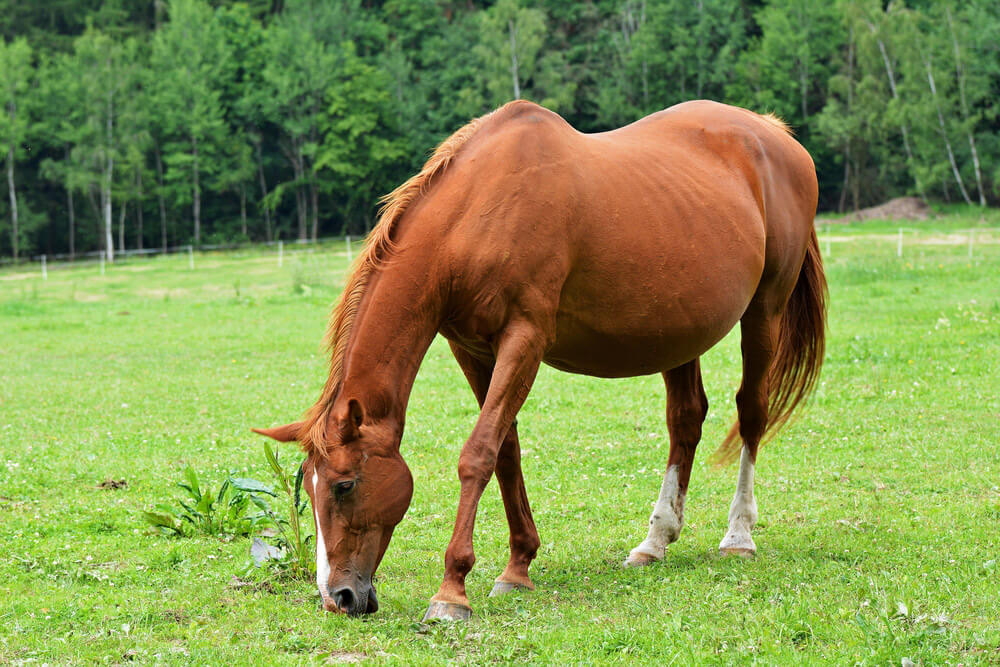
Horse Gestation Timeline
Here’s a detailed horse gestation timeline that is divided into three trimesters.
First Trimester
| Day 0: | Ovulation. |
|---|---|
| Days 14-16: | Horse pregnancy test by ultrasound and twin-check. |
| Day 18: | Repeated ultrasound testing may be needed in order to twins check. |
| Days 25-30: | Ultrasound check for a heartbeat, twin-check. |
| Days 45-60: | Another conceiving ultrasound examination to check the heartbeat and the overall fetus’ state of health. |
| Days 60-90: | First mare deworming. Ultrasound examination in order to get the sex of the fetus. |
Second Trimester
| Day 114: | The second trimester is coming. |
|---|---|
| Days 120-150: | Transabdominal ultrasound examination can be done in order to check the sex of the fetus. |
| Day 150: | Getting the first Equine Herpesvirus 1 (EHV-1) vaccine. Second mare deworming. |
| Day 210: | Getting the second Equine Herpesvirus 1 (EHV-1) vaccine. |
Third Trimester
| Day 226: | The third trimester is coming. |
|---|---|
| Day 270: | Getting the third Equine Herpesvirus 1 (EHV-1) vaccine. |
| Day 300: | Enhancing mare’s nutrition. Getting ready for foaling. Third mare deworming. The vulva opening after the caslicks procedure is required before foaling. |
| Days 320-365: | Checking the mare getting ready for foaling. Getting used to the place where she’s about to give birth. |
| Day 340: | The process of foaling. The horse gestation period is over. |
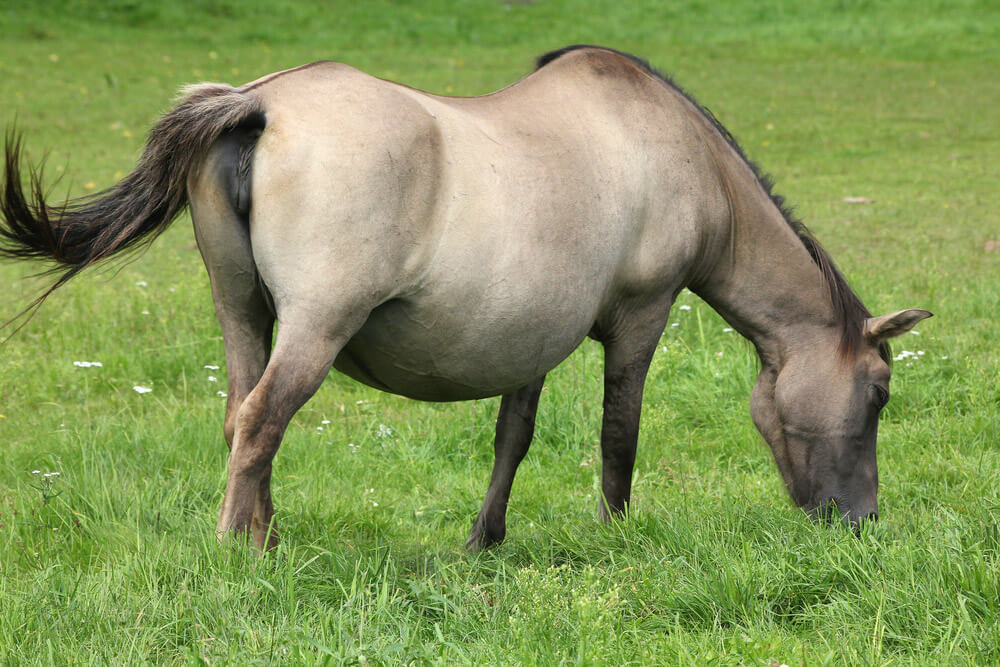
How to Take Care of a Pregnant Mare
In order to provide a flawless mare gestation period as well as foaling, visit a vet regularly and check the horse’s health. Apart from usual prescriptions, you may need extra supplements and appropriate nutrition.
How to make your horse feel better throughout the horse pregnancy stages? Here are some tips that may come in handy.
Exercise
At an early stage of being conceived, it’s believed that riding a pregnant mare is beneficial. However, this is relatable to healthy horses only with no high-risk of abortion. So you can saddle up your companion with no worries and enjoy the ride. You can perform the gaits or even jump during the first eight months after breeding.
Riding after eight months is possible but you should reduce the workload. Trail riding is more acceptable in this case. As the fetus is getting bigger and it starts grabbing more place. It is becoming harder to carry the baby, so ride your horse carefully not to harm her.
Additionally, don’t make the mare rest at one place all the time during the horse gestation period. When she can’t bear the rider anymore, let her walk from time to time to stretch a bit and get fresh air. Keep in mind that constant standing at the paddock may lead to the legs swelling, which is inappropriate.
How Long Can You Ride a Pregnant Mare?
Surroundings
As we already mentioned, don’t isolate the mare in the barn keeping her immovable. Apart from stiff muscles, you separate her from other horses, which is not recommended. As a horse is deemed as a herd animal, communication with mates is a vital part of their social lives.
Thus, don’t neglect to let the mare out to the open pasture. On the other hand, check the tall fescue for the fungus that may be hidden in the grass. It could negatively affect future birth. Besides, it’s not recommended to let the mare graze in the tall fescue two months before foaling.
In fact, an expecting horse tends to become less active two weeks before delivery. She usually rests more frequently, hence, she keeps the distance from the herd and splits up. The mare needs more privacy and peace to get ready for foaling.
Health Care
A mare during gestation is more vulnerable to get sick. And this may result in abortion. That’s why it’s better to visit the vet who can recommend proper vitamins and vaccines. They could enhance the immune system of the mare and her fetus in order to get through the pregnancy with no complications.
Apart from vaccination, deworming is essential as well. Discuss the schedule with your veterinarian in advance. Deworming shouldn’t be done one month before foaling.
Additionally, keep the horses that are taking part in competitions away from the mare, as they are at a high risk of spreading illness. If you use the same grooming tools for different horses, disinfect them on a regular basis. The same goes for the barn cleaning: keep it neat and washed.
Nutrition
An expecting mare is eating for two, thus balanced nutrition is at the top of the agenda. In fact, the foal requires a lot of protein and minerals in order to grow up duly. That’s why you need to think over feeding your horse to provide a healthy gestation period.
The research shows that a pregnant mare needs calories 28% higher than regularly. Besides, raise protein to 42% and calcium to 80%. Increase the amount of food gradually to avoid overeating. You can consider investing in high-protein supplements to reach the desired nutrition.
In terms of feeding, keep a grass hay diet and avoid grain. In fact, vegetable oil may be added to the meals. Don’t forget about fresh water and a salt block. Contact your veterinarian in order to plan the proper nutrition for your pregnant mare beforehand.

The Process of Foaling
The horse parturition includes three stages: proper positioning of the foal, the foaling itself, and placenta eliminating. If you’re going to take part in the foal delivery, it’s crucial to determine these phases and know what to expect.
Proper Positioning
The stage starts with the foal moving and changing its position to get through the birth canal. The fetus extends his neck and forelimbs for a better position. Meanwhile, the mare can help her foal by getting up and down throughout the process. She is likely to behave nervously, kicking at the tummy.
The last step is when the allantoic fluid appears that lubricates the birth canal. The process of foaling usually takes from 1 to 4 hours.
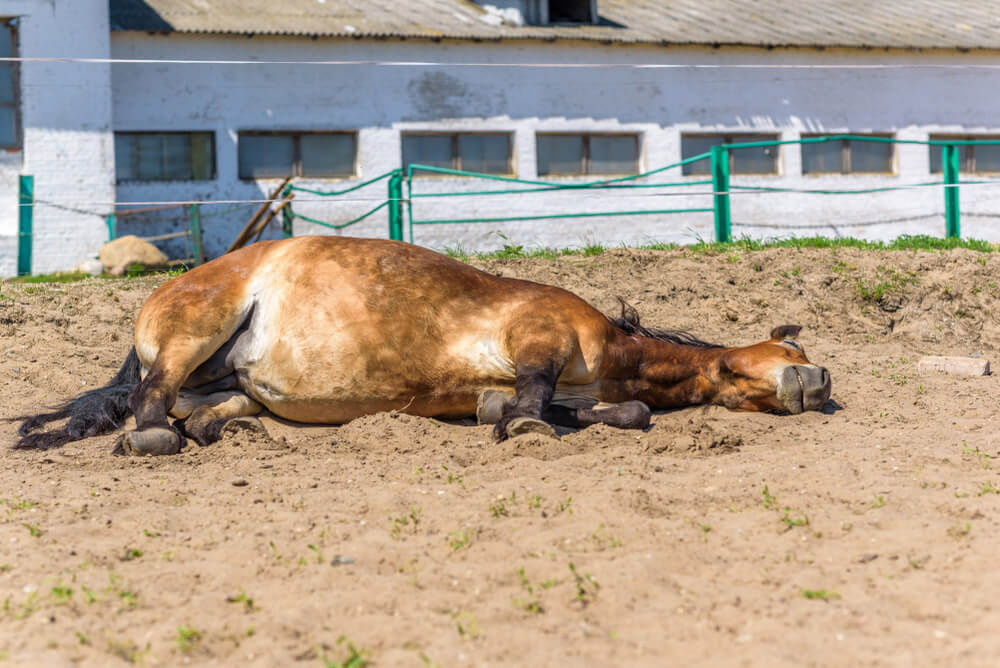
Foaling
The phase of giving birth starts with strong contractions of the uterine muscles. The mare begins expulsion. She may change her position in order to hold her foal to come out. If the mare is about to birth in a standing position, it’s better to stand nearby and catch the foal to avoid injuries when he falls down.
At the same time, the foal’s forelimbs show up, while one of the legs is positioned a bit forefront than the other one. Such a pose makes the foal passing by easier. Soon after the mare pushes again and the rest of the baby’s body is coming out.
In fact, with a foal delivery, the amnionic fetal membrane breaks down to free movements and make it able to breathe. If you find out it’s still not broken, get closer and tear the membrane right away.
After the hind legs pass through the birth canal, the mare can take a rest once again. It may take up to an hour when she stands up again and the umbilical cord tears up. While she is resting, the blood transfers from the placenta to the foal through the cord. Watch the foal gets the necessary blood until the cord is broken.
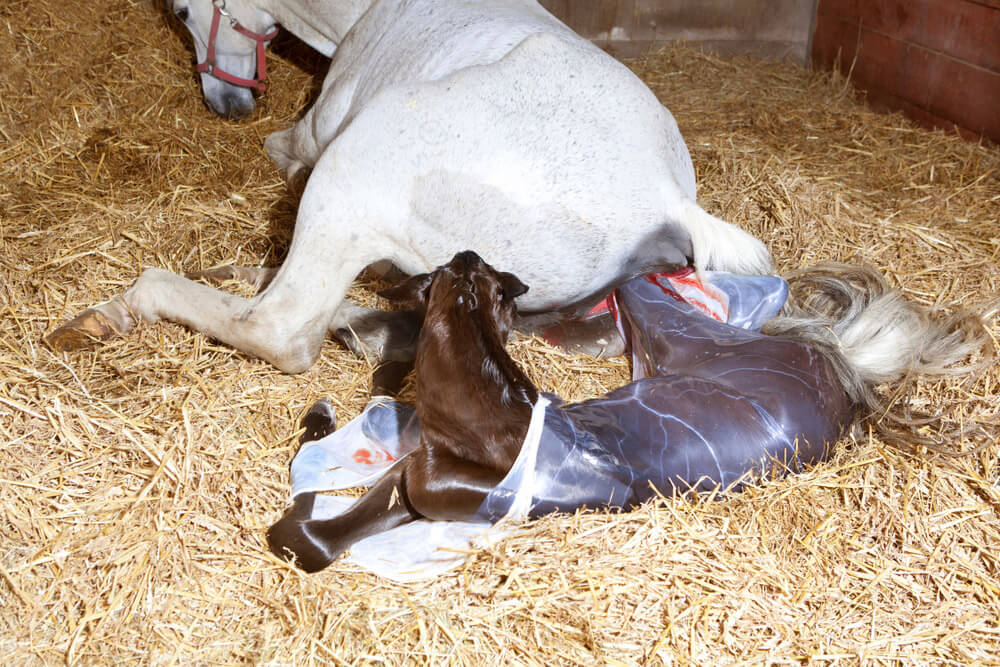
Placenta Eliminating
The last phase of foaling is getting rid of the placenta. This can be done right after the delivery, however, the entire process can last up to several hours. The contractions are still occurring in order to make the placenta come out of the mare. After a while, the uterus gets back to its normal size.
Keep in mind that you must not pull the placenta from the mare’s channel as this may lead to uterine infections. But you should check the placenta for its texture. If it’s too thick or has haemorrhagic areas, it may be a sign of the placental infection. If you’re not sure about the placenta’s condition, take a sample and show it to your vet.
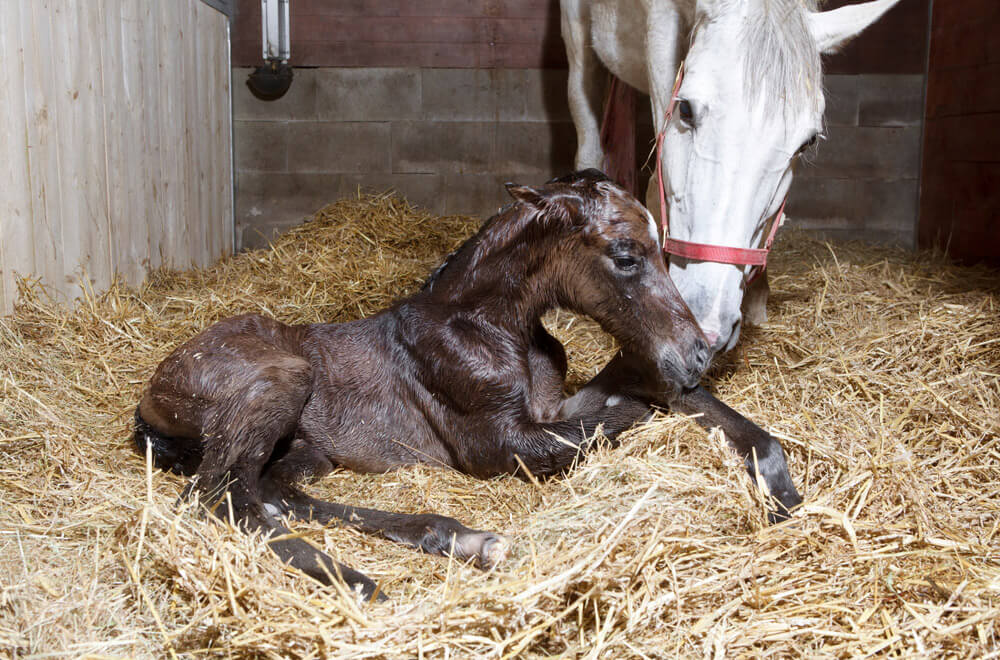
Conclusion
As you can see, the horse gestation period requires lots of aspects to be considered. As the due date takes almost a year, you should constantly take care of a pregnant mare and do some tests.
In fact, horse pregnancy stages are divided into three trimesters while the fetus is growing up and developing. Check the horse pregnancy timeline to be aware of the major changes before delivery. Besides, a mare gestation calculator may come in handy to get the birth date.
Treat your horse well, visit your vet in time, watch her foaling and you will get a healthy baby horse with no worries.
Image Source: shutterstock.com, unsplash.com, veteriankey.com.
